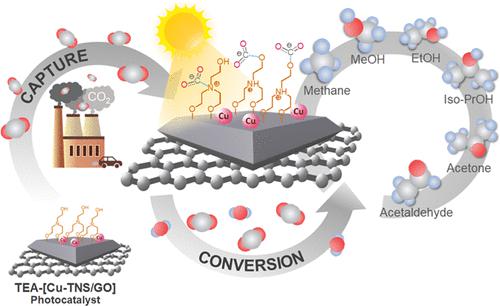当前位置:
X-MOL 学术
›
ACS Appl. Energy Mater.
›
论文详情
Our official English website, www.x-mol.net, welcomes your
feedback! (Note: you will need to create a separate account there.)
Alkanolamine-Grafted and Copper-Doped Titanium Dioxide Nanosheets–Graphene Composite Heterostructure for CO2 Photoreduction
ACS Applied Energy Materials ( IF 5.4 ) Pub Date : 2023-10-24 , DOI: 10.1021/acsaem.3c01675 Apisit Karawek 1 , Nutkamol Kitjanukit 1 , Wannisa Neamsung 1 , Chonlathon Kinkaew 2 , Poomiwat Phadungbut 1 , Panpailin Seeharaj 3 , Pattaraporn Kim-Lohsoontorn 4 , Sira Srinives 1
ACS Applied Energy Materials ( IF 5.4 ) Pub Date : 2023-10-24 , DOI: 10.1021/acsaem.3c01675 Apisit Karawek 1 , Nutkamol Kitjanukit 1 , Wannisa Neamsung 1 , Chonlathon Kinkaew 2 , Poomiwat Phadungbut 1 , Panpailin Seeharaj 3 , Pattaraporn Kim-Lohsoontorn 4 , Sira Srinives 1
Affiliation

|
CO2 photoreduction is an intriguing approach to carbon capture, utilization, and storage (CCUS). It relies on an effective photocatalyst to generate photoinduced electrons that incorporate carbon dioxide (CO2), yielding fuel products, e.g., methane, methanol, and ethanol. The heterostructure of titanium dioxide nanosheets (TNS) and graphene oxide (GO) is a sandwich-type composite consisting of two 2-dimensional nanostructures (2D–2D). It was demonstrated as an excellent candidate for CO2 photoreduction due to its outstanding charge separation ability. This research studied the photoactivity of alkanolamine-grafted TNS and alkanolamine-grafted and copper-doped TNS/GO composites. In the first experiment, triethanolamine-grafted TNS (TEA–TNS) exhibited the best ability in CO2 photoreduction compared to monoethanolamine- and diethanolamine-grafted TNS (MEA–TNS and DEA–TNS) due to the base-catalyzed hydration nature of CO2–TEA interactions. In the second experiment, we studied the photoactivity of four composites, including copper-doped TNS/GO (Cu-TNS/GO), TEA-[Cu-TNS/GO] (grafting TEA on Cu-TNS/GO), Cu-[TEA-TNS]/GO (doping Cu on TEA-TNS/GO), and TEA-Cu-TNS/GO (one-step hydrothermal synthesis with the Cu precursor, TEA, and GO). TEA-[Cu-TNS/GO] showed the best photoactivity since TEA was added last to the heterostructures, which benefited in avoiding side chelation reactions between TEA and Cu ions and ensuring TEA exposure to CO2.
中文翻译:

烷醇胺接枝铜掺杂二氧化钛纳米片-石墨烯复合异质结构用于CO2光还原
CO 2光还原是一种有趣的碳捕获、利用和储存(CCUS)方法。它依靠有效的光催化剂产生光生电子,结合二氧化碳(CO 2 ),产生燃料产品,例如甲烷、甲醇和乙醇。二氧化钛纳米片(TNS)和氧化石墨烯(GO)的异质结构是由两个二维纳米结构(2D–2D)组成的夹心型复合材料。由于其出色的电荷分离能力,它被证明是CO 2光还原的优秀候选者。本研究研究了烷醇胺接枝的 TNS 和烷醇胺接枝铜掺杂的 TNS/GO 复合材料的光活性。在第一个实验中,由于CO的碱催化水合性质,与单乙醇胺和二乙醇胺接枝的TNS(MEA-TNS和DEA-TNS)相比,三乙醇胺接枝的TNS(TEA-TNS)表现出最佳的CO 2光还原能力2 –茶相互作用。在第二个实验中,我们研究了四种复合材料的光活性,包括铜掺杂TNS/GO(Cu-TNS/GO)、TEA-[Cu-TNS/GO](在Cu-TNS/GO上接枝TEA)、Cu- [TEA-TNS]/GO(在 TEA-TNS/GO 上掺杂 Cu)和 TEA-Cu-TNS/GO(用 Cu 前驱体、TEA 和 GO 一步水热合成)。TEA-[Cu-TNS/GO]表现出最好的光活性,因为TEA最后添加到异质结构中,这有利于避免TEA和Cu离子之间的侧螯合反应并确保TEA暴露于CO 2。
更新日期:2023-10-24
中文翻译:

烷醇胺接枝铜掺杂二氧化钛纳米片-石墨烯复合异质结构用于CO2光还原
CO 2光还原是一种有趣的碳捕获、利用和储存(CCUS)方法。它依靠有效的光催化剂产生光生电子,结合二氧化碳(CO 2 ),产生燃料产品,例如甲烷、甲醇和乙醇。二氧化钛纳米片(TNS)和氧化石墨烯(GO)的异质结构是由两个二维纳米结构(2D–2D)组成的夹心型复合材料。由于其出色的电荷分离能力,它被证明是CO 2光还原的优秀候选者。本研究研究了烷醇胺接枝的 TNS 和烷醇胺接枝铜掺杂的 TNS/GO 复合材料的光活性。在第一个实验中,由于CO的碱催化水合性质,与单乙醇胺和二乙醇胺接枝的TNS(MEA-TNS和DEA-TNS)相比,三乙醇胺接枝的TNS(TEA-TNS)表现出最佳的CO 2光还原能力2 –茶相互作用。在第二个实验中,我们研究了四种复合材料的光活性,包括铜掺杂TNS/GO(Cu-TNS/GO)、TEA-[Cu-TNS/GO](在Cu-TNS/GO上接枝TEA)、Cu- [TEA-TNS]/GO(在 TEA-TNS/GO 上掺杂 Cu)和 TEA-Cu-TNS/GO(用 Cu 前驱体、TEA 和 GO 一步水热合成)。TEA-[Cu-TNS/GO]表现出最好的光活性,因为TEA最后添加到异质结构中,这有利于避免TEA和Cu离子之间的侧螯合反应并确保TEA暴露于CO 2。






























 京公网安备 11010802027423号
京公网安备 11010802027423号